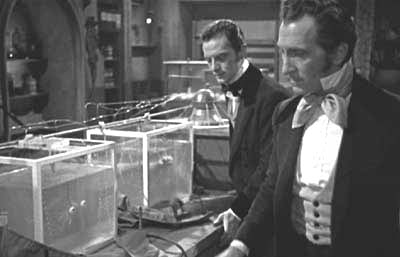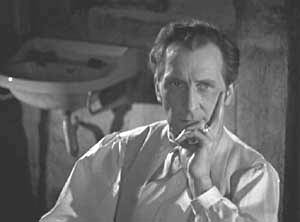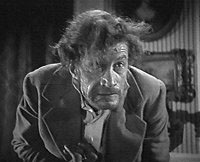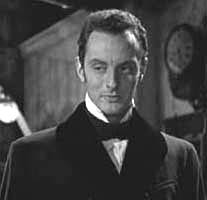|
Revenge of Frankenstein (1958)
Having scored a major success with Curse of Frankenstein, Hammer
Studios began to realise the financial potential of horror movies. They
chose to specialise in gothic horror and brought back most of Curse
of Frankenstein's team, including Peter Cushing, screenwriter Sangster and director Fisher, to produce a sequel. It was filmed in 1958
back-to-back with Hammer's equally successful Dracula (starring
Christopher Lee as the evil Count, also directed by Terence Fisher) and
the movies shared many sets, e.g the castle exteriors and the crypt.
Synopsis:
Revenge of Frankenstein begins where Curse
of Frankenstein ends: the Baron (Peter Cushing) is
dragged to the guillotine and - so
it seems - beheaded. But we soon learn that Frankenstein is not dead. When two
drunkards open the Baron's grave the headless body of a preacher is revealed.
Then Frankenstein himself appears scaring one of the drunkards to death.
Three years later, Frankenstein, who now calls himself "Dr.
Stein", is the head of a hospital for poor people in Carlsbruck. A
young doctor, Hans Kleve, approaches Frankenstein telling him that he
knows his true identity because he saw him at Professor Bernstein's
funeral. Frankenstein introduces Kleve to his experiments and accepts him
as his new assistant. Frankenstein's second assistant is the crippled dwarf Carl,
who helped to save the Baron from the guillotine. Carl agrees to donate his brain to be
transplanted into a new body because he hopes that this operation will rid him of
his deformed body. The experiment is successful and the "new" Carl is locked
up in a room in the hospital attic. A merciful nurse, Margret Conrad, learns of the
new patient and frees him. Carl sneaks into the lab and
burns his old body. There he is discovered by the janitor who tries to
stop him. During the struggle Carl gets hit and his freshly translanted
brain suffers serious damages. Going insane, the enraged Monster kills the
janitor and later murders a little girl. On a party, the Monster, who is
now
rapidly degenerating and whose
leg and arm have become crippled again, breaks through a window,
approaches the Baron shouting, "Frankenstein, help me!" and
dies. Frankenstein, whose identity is now revealed, returns to the
hospital, where he is nearly beaten to death by the outraged patients. Kleve
arrives just in time to save the dying Baron. He takes Frankenstein to the lab and transplants
the deceased Baron's brain into an artificial body, an exact copy of Frankenstein's old
body. The film ends in London, where Frankenstein now works under the
pseudonym of Dr. Franck.
| Eyeballs,
severed hands and other body parts - Frankenstein (Peter Cushing)
and his assistant Hans Kleve (Francis Matthews) at work in the laboratory |
 |

What is the Baron (Peter Cushing) pondering? |
The plot of Revenge of
Frankenstein does not have much in common with Mary Shelley's novel.
Jimmy Sangster's script is a continuation of Hammer's first Frankenstein
film, and again concentrates on the person of Baron Victor
Frankenstein. His negative features were toned down in comparison to the
film's predecessor. Sometimes he even seems to be benevolent, when he works in a hospital for poor people and creates a new body for
his miserable assistant Karl. But after a while it becomes clear that he has not
changed much since Curse of
Frankenstein. When Frankenstein discovers a beautiful tattoo on a patient's arm
he simply amputates the limb in order to attach it to a duplicate of his
own body. And the reason why he transplants the brain of his crippled
assistant Karl into a new, flawless body is not to free him from his handicap but
rather to show him on congresses and at
universities as the perfect result of his scientific work. Frankenstein is
still an egotistic person, a perfect example of the "mad
scientist" whose sole obsession is his work.
|
|
A very interesting aspect of the script is the film's ending, where
creator and Monster practically blend into one person.
When Frankenstein's assistant Kleve surgically transplants the brain of the
deceased
Baron into a duplicate of his body, Frankenstein himself becomes the
artificial creature. Before this operation Frankenstein could be regarded the film's
real
monster only because of his evil character features. But now he also
possesses the physical
features of a Frankenstein monster since his own body is made from dead body
parts. Just as the name "Frankenstein" had become synonymous for both the
creator and the creature in the public mind, Revenge of
Frankenstein blends those two characters into one person. |

A new body and a slightly changed look
for Dr. Franck. |

The Monster (Michael Gwynn)
wants a word with his creator |
In comparison to the
first film in Hammer's series the Monster's character was changed considerably. It is now more
human than in Curse of Frankenstein
and obviously suffers when the Baron locks it up in the attic. In fact, the Monster
is a human being - Frankenstein's assistant Carl - fully equipped with emotions and
feelings. He is even capable of falling in love with the beautiful nurse Margret and
originally has no bad
intentions whatsoever. Carl only becomes evil when his brain is damaged during a
fight with the janitor. This tragic aspect brings this film's Monster much
closer to Shelley's Monster, which only became evil because it was
attacked and rejected by society for its hideous physical appearance. Rather than being a victim of society the Monster in Revenge
of Frankenstein is primarily a victim of the evil Baron Frankenstein,
who exploits Carl for his experiments and never treats him as a
human being. Frankenstein considers him his property and sees him more as a thing
than a human being. |
|
Frankenstein's young assistant Kleve is the character that comes
closest to Mary Shelley's concept of Victor Frankenstein. Although he
participates in the Baron's experiments he never acts selfishly. His
interest is knowledge and he studies for the good of mankind. But he also
seems to be a bit naive, when he recognises Frankenstein's egotistic
motives and his evil character. To him Frankenstein is a kind of father
whose experiments he refuses to question. Even when he learns that a monkey with a brain transplant has became
carnivorous after the operation and ate its female mate, Kleve does not
confront his mentor. In the end Kleve himself becomes the true Frankenstein figure of this film when he
finishes his mentor's work by transplanting the
Baron's brain into an artificial body and thereby turning Baron Frankenstein
into an artificial Monster. But Kleve is also what Kempe was in the first film. His character
gives the young audience a chance to identify with someone else rather
than the 40-something old Victor Frankenstein. |

Hans Kleve |
Revenge of Frankenstein and
all the following sequels are continuations of the new Frankenstein myth
Hammer had established in their first film. Victor Frankenstein is reduced
to the evil mad scientist, who resembles Dr. Pretorius in James Whale's Bride of Frankenstein. He is ruthless and the film's true
monster/villain. His creations all turn out to be evil killers because somehow
their brains are damaged, a motif also found in James Whale's films. The true
Frankenstein, the guilt-ridden, knowledge-hungry scientist, is a young
assistant, who (often) involuntarily becomes part of Frankenstein's
crimes. In the sequels these basic set-ups were always slightly modified and
embedded in more or less grotesque plotlines, which however make fine
examples of British gothic horror films and helped to establish Hammer Studios as
the major European horror film producers.

|
Cast & Crew: |
|
| |
|
|
Victor Frankenstein |
Peter Cushing |
| Hans Kleve |
Francis Mathews |
| Margaret Conrad |
Eunice Gayson |
| Carl the Monster |
Michael Gwynn |
| Carl, the dwarf |
Oscar Quitak |
| |
|
| |
|
|
Screenplay |
Jimmy Sangster |
|
Music |
Leonard Salzedo |
|
Cinematography |
Jack Asher |
| Producers |
Anthony Hinds
Anthony Nelson Keys
Michael Carreras |
| Director |
Terence Fisher |


|


